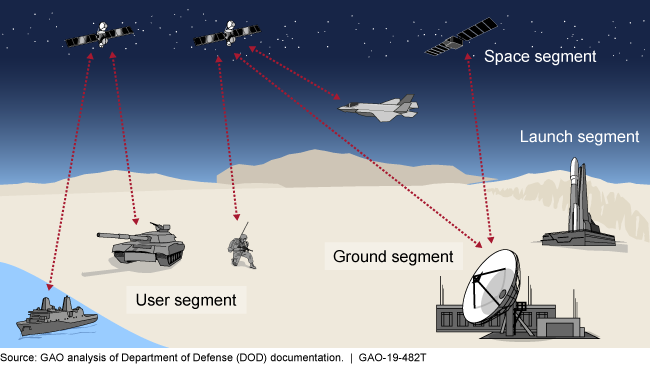Space Acquisitions: DOD Faces Significant Challenges as it Seeks to Address Threats and Accelerate Space Programs
Fast Facts
This testimony updates the House on DOD space system acquisitions, such as satellites and ground equipment.
Our work has found many major DOD space programs exceed their budgets and are late. For instance, the cost of a satellite communications system has grown 117% and its first launch was delayed more than 3.5 years.
Today, as DOD is simultaneously undertaking major acquisitions to replenish missile warning, communications, navigation, and weather satellites, it faces:
Growing threats to satellites including cyber attacks and space debris
Major proposed space leadership changes
Funding and acquisition workforce challenges
The Segments of Space Systems

A graphic showing the segments of space systems: Ground, User, Launch, and Space.
Highlights
What GAO Found
DOD is simultaneously undertaking new major acquisitions to replenish its missile warning, protected communications, navigation, and weather satellites. At the same time, it is boosting efforts to increase space situational awareness and protect space assets. Such widespread acquisition acitivites could face a wide range of resource and management challenges that GAO has reported on, including:
- Growing threats to satellites. Threats to satellites from both adversaries—such as jamming and cyber attacks—and space debris are increasing. DOD is making changes to how it designs its space systems to increase the resilience and survivability of space capabilities. But it has been challenged in adopting new approaches, such as using commercial satellites to host payloads, and in prioritizing cybersecurity for all of its weapon systems. For hosted payloads, GAO recommended, and DOD concurred, that the department bolster and centralize collection and analysis of cost, technical, and lessons learned data.
- Implementing leadership changes. DOD is planning major changes to leadership for space. It recently proposed legislation to establish a United States Space Force—initially to be housed within the Department of the Air Force—that would, according to the President's Space Policy Directive, consolidate existing military space activities and minimize duplicative efforts across DOD. GAO found in July 2016 that changes are needed to reduce fragmentation that has negatively affected space programs for many years. But open questions remain about governance as new programs get underway and whether the changes themselves may result in further fragmentation. For example, it is unclear at this time how the new Space Development Agency will mesh with organizations currently involved in testing and acquiring new space technologies.
- Having the right resources and know-how. While there is increased attention on funding for space and building the Space Force, new programs can still face resource challenges. DOD has begun over 9 new space programs at a time when it is also seeking increased investments in ships, aircraft, and the nuclear triad, among other programs. Moreover, it is unclear whether DOD has a sufficient workforce to manage its new programs. GAO issued a report last month that found DOD does not routinely monitor the size, mix, and location of its space acquisition workforce. Further, DOD has difficulty attracting and retaining candidates with the requisite technical expertise. GAO recommended that DOD collect and maintain data on its space acquisition workforce. DOD did not concur, but GAO maintains that DOD should have better information on such personnel, especially in light of its proposal for establishing the Space Force. GAO also found in March 2019 that selected software-intensive space programs often did not effectively engage users to understand requirements and obtain feedback. GAO recommended, and DOD concurred, that the department ensure its guidance addressing software development provides specific, required direction on the timing, frequency, and documentation of user involvement and feedback.
Why GAO Did This Study
DOD space systems provide critical capabilities that support military and other government operations. They can also be expensive to acquire and field, costing billions of dollars each year.
As DOD seeks to replenish its satellite constellations, it faces a number of challenges to ensuring funds are used effectively. Because space-based capabilities are fundamental to U.S. national security and civilian activities, it is essential that DOD manage its space system acquisitions carefully and avoid repeating past problems.
This statement provides an update on DOD's space acquisitions, focusing on challenges facing acquisitions of new space systems.
This statement is based on GAO reports issued over the past 10 years on DOD space programs. In addition it draws on recent work performed in support of GAO's 2019 annual reports on the progress of major defense acquisition programs as well as duplication, overlap, and fragmentation across the federal government, among other sources.
Recommendations
Past GAO reports have recommended that DOD adopt acquisition best practices to help ensure cost and schedule goals are met. DOD has generally agreed and taken some actions to address these recommendations.
